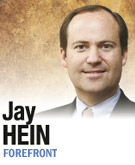Subscriber Benefit
As a subscriber you can listen to articles at work, in the car, or while you work out. Subscribe Now
 On Jan. 10, Pat Quinn was inaugurated as Illinois governor, merely two years after first taking office when his predecessor, Rod Blagojevich, resigned amid criminal prosecution. Two days into his new term and facing a $15 billion state budget shortfall—an amount nearly half the state’s operating fund—Quinn signed a law increasing the personal income tax a whopping 67 percent as well as a 46-percent tax increase on business.
On Jan. 10, Pat Quinn was inaugurated as Illinois governor, merely two years after first taking office when his predecessor, Rod Blagojevich, resigned amid criminal prosecution. Two days into his new term and facing a $15 billion state budget shortfall—an amount nearly half the state’s operating fund—Quinn signed a law increasing the personal income tax a whopping 67 percent as well as a 46-percent tax increase on business.
The same week, Indiana Gov. Mitch Daniels delivered his penultimate State of the State address before a Republican majority committed to fulfilling his bold agenda of spending cuts and needed reforms in local government and education. Daniels’ speech also drew a national audience of reporters and politicos interested in whether he will make his next bid for office outside Indiana in 2012.
Illinois and Indiana do not simply offer opposite tales of political fortunes. Rather, a closer examination of the states’ contrasting policies reveals an interesting experiment in the proper role for government in response to economic distress. To tax or cut spending, that’s the question.
It starts with philosophy. One of the national observers of Daniels’ State of the State address was David Leonhardt, who writes on economic issues for The New York Times. Betraying the classic Washington mind-set, Leonhardt asked the Indiana governor what government should do to spruce up the economy. Daniels replied that it should merely “enable and facilitate the flourishing of private life. That is to say it should protect the liberties and the safety of citizens, first and foremost, and then it should act to make possible … the growth of the private sector, on which everything else depends.”
He continued that the American Experiment itself is in peril due to the gargantuan debt we’ve accumulated and the unprecedented bills coming due in entitlement spending. Daniels thinks this economic threat to our citizens is equal to the Cold War. Inaction is unacceptable and government taxation is wrongheaded. Indiana’s prescription is as old-fashioned as it is common sense: Don’t spend what you don’t have.
Such wisdom is validated in a late 1980s report by the Joint Economic Committee that determined every new dollar of taxes led to $1.58 in new spending by Congress. In other words, what was intended as bailout (new taxes to pay for government overspending) actually resulted in more government spending. The “$1.58 study” ought to be foremost in every fiscal policy debate. The calculus of political appropriations amounts to spending whatever comes in … plus a little more.
Illinois legislators are trying to disprove this formula by doubling down on their debt and asking their citizens to send bailout money to Springfield. According to the Tax Foundation, the Prairie State’s businesses will now pay the highest combined national-local corporate tax rate in the industrialized world.
On the day of the tax vote, which passed strictly along party lines, Republican State Sen. Kyle McCarter had some advice for his colleagues: “Here’s an investment tip; put a lot of money in moving vans.”
Newly elected Wisconsin Gov. Scott Walker campaigned on the Daniels-inspired parsimony theme and he responded to the Illinois tax increases by inviting businesses to “Escape to Wisconsin.” The Indiana Economic Development Corp. has announced an ad campaign suggesting an eastern rather than northern migration.
Yet, Daniels took the high road when asked by reporters about Illinois’ fate. He noted that the upper Midwestern states represent parts of the same region and that Illinois’ and Michigan’s recent inhospitality to growth creates a chill factor for its neighbors.
It is common to perceive today’s Midwest as lagging the innovation and economic prosperity found on the coasts. However, the opposite was true at the dawn of the last century. The Great Lakes states were the Industrial Era’s engine and its railways and waterways were a key junction in America’s transportation system.
To regain such prominence, Indiana is showing its neighbors the way ahead.•
__________
Hein is president of Sagamore Institute, an Indianapolis-based think tank, and was an official in the administration of George W. Bush. Send comments on this column to ibjedit@ibj.com.
Please enable JavaScript to view this content.
